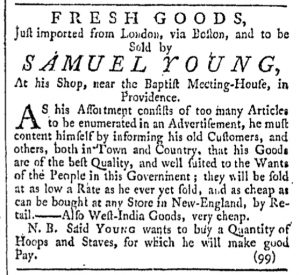What was advertised in a colonial American newspaper 250 years ago today?

“At as low a Rate as he ever yet sold, and as cheap as can be bought at any Store in New-England, by Retail.”
Throughout the eighteenth century shopkeepers and merchants consistently made appeals to price as they attempted to incite demand for their wares. Almost every advertisement for consumer goods and services in the November 21, 1767, edition of the Providence Gazette, for instance, made some sort of reference to low prices. While some advertisers resorted to formulaic language, others devised increasingly innovative and elaborate ways of promoting bargain prices to potential customers. These appeals ranged from simple to bold.
Joseph and William Russell characterized their prices as “very cheap.” Similarly, Jonathan Russell offered an array of imported merchandise “at the very cheapest rate,” allowing the typography to provide additional emphasis. In terms of standardized language, advertisers frequently used both “cheap” and “reasonable” to describe their prices. Archibald Stewart and Robert Taylor promised to sell their goods “at the most reasonable rates.” Edward Thurber pledged to “sell on the most reasonable Terms” at his shop at the Sign of the Brazen Lion. Jabez Bowen, Jr., used the same phrase, one encountered in newspaper advertisements throughout the colonies.
Rather than merely claim that they set low prices, some advertisers favorably compared their prices to what consumers could expect to pay elsewhere. Samuel Nightingale, Jr., asserted that he “will sell as cheap as any Person in Town.” Nathaniel Greene made a similar claim, stating the he was “determined to sell [his goods] as low as any are sold in this Town.” Not to be outdone, Samuel Black and James Brown proclaimed that they “will sell as cheap as are sold in New-England by Retail.” Samuel Young also raised the stakes, trumpeting that he sold his merchandise “at as low a Rate as he ever yet sold, and as cheap as can be bought at any Store in New-England, by Retail.” While not quite as verbose, Benjamin Thurber and Daniel Cahoon professed “to sell … as cheap as any Person in this Town, or elsewhere.” Potential customers did not need to look to Boston or New York for better deals!
Gideon Young inserted perhaps the most novel appeal to price, assuring readers “of having the full Worth of their Money,” but he followed that with formulaic language about “the very lowest rates.” Regardless of how they described their prices, retailers regularly noted them as a means of enticing prospective customers to visit their shops. Their advertisements were not mere announcements about goods for sale that relied on incipient consumer demand; instead, eighteenth-century shopkeepers promised bargains as a means of marketing their merchandise to customers who sometimes needed to be convinced to make purchases.
